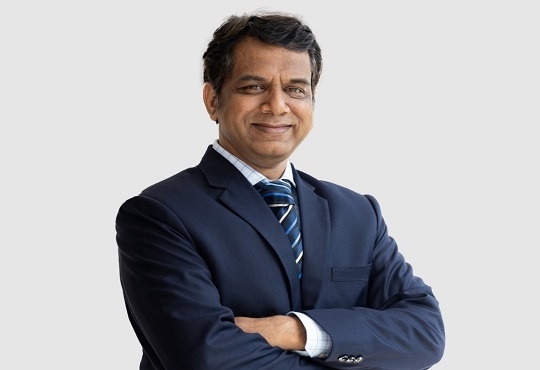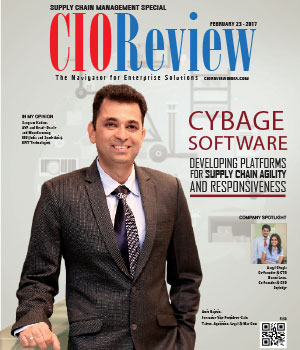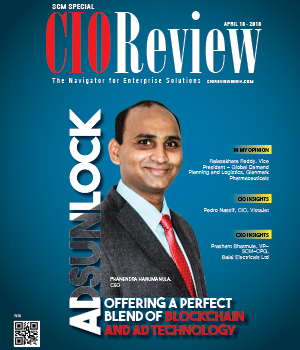
Role of IT in Enhancing Efficiency and Visibility in End-to-End Logistics
Sreenivas Pamidimukkala, Chief Information Officer, Mahindra Logistics | Sunday, 17 September 2023, 12:19 IST

In an interaction with CIOTechOutlook, Sreenivas Pamidimukkala, Chief Information Officer, Mahindra Logistics shared his insights on the major challenges in leveraging IT for efficiency and visibility of end to end logistics operation, achieving end-to-end supply chain visibility, the role of real time data analytics in improving efficiency and visibility in the logistic process and more. He has extensive experience in major enterprises directing IT strategy, building system roadmaps, and leading support and implementation projects.
IT plays a vital role in enhancing efficiency and visibility in end to end logistics by enabling real time data exchange and optimizing processes. What are the major challenges in leveraging IT for efficiency and visibility of end to end logistics operation?
IT plays a crucial role not only in logistics but across all industries today; significant changes are evident worldwide. There is a global emphasis on ID technologies, and every company requires an ID solution. Logistics is particularly impacted due to the diverse nature of businesses and industries it serves. Every customer has unique ID systems, making integration a fundamental necessity for logistics. As logistics comes into play, we should have the capability to integrate with these multiple systems. These are some significant changes in the logistics landscape. Technology is an integral player in logistics, providing end-to-end visibility. For example, in our warehousing and transportation services, real-time GPS tracking allows customers to monitor their shipments' exact locations. So, through GPS-run system, we can actually pinpoint the exact position of the shipment. We have integrated it with mapping services such as MapmyIndia and Google Maps. We bring in technology so that we can increase productivity in the warehouse. In our warehouses, technology enhances productivity, aligning with our customers' goals of optimizing supply chain costs.
Achieving end-to-end supply chain visibility is a complex challenge due to the involvement of various stakeholders, modes of transportation, and geographic locations. How can logistics CIOs address this?
Today, when a customer approaches us, they may express interest in specific services such as transportation or warehousing. It is crucial that our customers do not encounter the complexity of navigating multiple systems to gain insights into their supply chain operations. In addition, we operate a freight forwarding company specializing in cross-border logistics. So, when a customer requests a unified view of their operations, we understand the need for a seamless experience. It is impractical to provide customers with multiple URLs and access points for different aspects of their logistics operations.
Our intent is to build a unified platform for our customers, offering them a comprehensive view of the entire supply chain from a single access point. Rather than requiring customers to navigate through multiple systems and interfaces, we aim to provide them with a streamlined experience where they can conveniently examine the entire supply chain through a singular portal. This platform will enable them to gain comprehensive insights into their entire supply chain without the hassle of juggling multiple systems and access points. This initiative aligns with our commitment to providing a one-stop solution, recognizing that each customer's business requirements are unique. We aim to ensure that our system is robust enough to deliver a tailored experience, where customers can access their specific services and obtain a clear overview of their supply chain through charts and graphs. This approach streamlines the logistics process and enhances the efficiency of our services.
How can data integration and inter-operability challenges be addressed to enhance visibility and efficiency in end to end logistics?
Data integration is critical because we work with multiple systems and service lines. Our customers have diverse source systems, and obtaining data from these systems is a key challenge. We cannot rely on manual Excel file transfers each time. Therefore, we have implemented an integration layer that connects to all our client systems. This integration layer prioritizes security, with robust cyber security protocols and two-factor authentication in place where the data moves synchronously. So, whenever a customer places an order, the order information is transferred in real-time to our warehouse management system through this integration. From there, the warehouse people will go and try to pick the order. The process is real time, with just a two or three-second gap before the order appears in our WMS. Given our reliance on multiple systems, integration is going to be very critical in our entire IT tech ecosystem and operational processes.
How can IT help overcome the complexities of multi-modal transportation and optimize logistics operations across different modes of transport?
IT plays a significant role because we are involved in multimode transportation. We are engaged in logistics, air cargo, and ocean cargo. In multimodal logistics, the advantage of synchronizing or integrating everything onto one platform is achieved through integrations.
For example, if we handle transportation and warehouse operations for a client, where materials are sourced from third parties overseas, we transport these materials using our containers to the port. From there, we perform Full Truckload (FTL) transportation to deliver them to the warehouse. Our goal is to integrate this entire process into a single system. This would enable clients to have real-time visibility into various aspects, such as the number of containers received at the port, the current status of trucks in transit, and their estimated arrival times at the warehouse. Such visibility is critical in multimodal logistics.
We aim to minimize the need for customers to inquire about their shipments. Instead, we are exploring the potential of an IoT (Internet of Things) platform to provide self-service capabilities for customers to track the status and location of their materials without the need for direct inquiries.
How can logistics CIOs incorporate sustainable practices within their operations, such as optimizing routes to reduce emissions and adopt eco-friendly packaging materials?
As a company, we intend to become carbon neutral by 2040. We are currently focusing on route optimization and load optimization. Route optimization entails determining the shortest route for package delivery, while load optimization involves consolidating multiple orders to maximize efficiency and reduce fuel consumption. Additionally, we provide customers with information about the carbon footprint associated with their shipments. We have recently partnered with a company that calculates our carbon emissions based on the number of shipments, allowing us to provide customers with this environmental impact data.
In our commitment to environmental sustainability, our warehouses are primarily powered by solar panels, and our offices are constructed using recycled materials. So, whatever we can do to contribute to environmental conservation, we are already taking those actions. We are committed to sustainability and are making significant strides in that direction.
CIO Viewpoint
Role of IT in Enhancing Efficiency and...
By Sreenivas Pamidimukkala, Chief Information Officer, Mahindra Logistics
IT Overhaul in an Enterprise Transformation
By Parveen Aery, SVP & CIO, Ocwen Financial Solutions
Internet of Things: The Rise of Connected...
By Harnath Babu, Chief Information Officer, KPMG India
CXO Insights
Evolution of Supply Chain Management driven by...
By Shalabh Raizada, Chief Information Officer, Stellar Value Chain Solutions
Emerging Trends on Fruits & Vegetables Supply...










